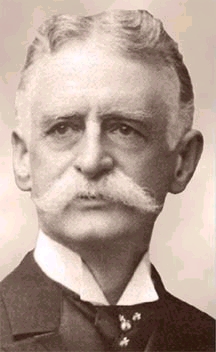Bankruptcy and Copyrights
Clemens returned to New York a month later. Webster and Company declared
bankruptcy on April 18, 1894. It was the same day the company published
their last Mark Twain book Tom Sawyer Abroad. In a brilliant move
to save Clemens's fortunes from his creditors, Rogers arranged to assign
the copyrights for Mark Twain's works to Clemens's wife Olivia. "Livy,"
whose personal fortune had been lost in helping fund the Paige typesetter
and propping up a failing Webster publishing company was considered the
primary creditor for the company and entitled to retain control of Clemens's
writings.
The Clemens family spent most of the next seven years abroad as Rogers
negotiated a maze of publishing contracts and other investments that would
restore Clemens to financial stability. The correspondence between Rogers
and Clemens over the ensuing years indicates Olivia Clemens also took an
active interest in developing a uniform edition of her husband's works.
The correspondence is filled with Clemens's own dreams, plans, hopes and
schemes to make the uniform edition a reality. Clemens, who was involved
in writing his next book which would be titled Personal Recollections
of Joan of Arc wrote to Rogers in December 1894 that Joan "will
make two full volumes of the proposed Uniform edition." Book length
in a uniform set was a major consideration and longer books would have to
be split into multiple volumes. On February 3, 1895 Clemens wrote to Rogers
about his plan to lecture around the world, "I suppose I can hire myself
out to Mrs. Clemens as a platform-reader ... I should expect the
trip to help sell my uniform edition" (Leary, p. 126-27).
Contract Negotiations
One of the first legal moves toward achieving publication
of a uniform edition was the contract Rogers negotiated between Olivia Clemens
and Harper and Brothers publishers dated May 23, 1895 and delivered to Harper
on July 26, 1895. Harper acquired the rights to Mark Twain books formerly
published by Webster and Company as well as those originally published by
James R. Osgood. These titles included Adventures of Huckleberry Finn,
A Connecticut Yankee in King Arthur's Court, Tom Sawyer Abroad,
The Prince and the Pauper, Life on the Mississippi, The
Stolen White Elephant, and The American Claimant. However, the
contract recognized that any uniform edition would not be complete without
other titles of works currently claimed by the Bliss family and American
Publishing Company. The contract specified that Pudd'nhead Wilson,
Innocents Abroad, The Gilded Age, Roughing It, A
Tramp Abroad, and Adventures of Tom Sawyer would be assigned
to Harper "at the earliest possible date." No uniform edition
edition of Mark Twain works would be complete without both Tom Sawyer
and Huckleberry Finn under the same bindings.
Harper began issuing Mark Twain's books in uniform binding
in 1896 beginning with five books provided to them via their contract with
Olivia Clemens. The following year, an advertisement in the book review
section of The New York Times on April 10, 1897 announced six titles,
with American Claimant being the latest edition.

Harper advertisement
from the book review section of The New York Times, April 10, 1897.
For the complete description of this edition see: Harper's
New and Uniform Library Editions - Red and Gold Cornstalks
American Publishing Company, however, was interested in publishing
a uniform set of Mark Twain's works by subscription. In addition, American
Publishing Company wanted the rights to continue to add new works that Twain
might write to their own uniform set. In further rounds of negotiations
conducted by Henry Rogers over the next several years, Harper and Brothers
and American Publishing Company arrived at a solution wherein American Publishing
Company could publish the Harper titles in their uniform edition and sell
them in sets only by subscription. Harper and Brothers would receive 8%
royalties on titles they owned that were included in the American Publishing
Company sets.
Harper and Brothers were also experiencing their own financial
difficulties. In late November 1896 through August 1899 they incurred a
heavy debt from the J. P. Morgan company to keep their publishing company
afloat. Business competition between the Harper and American Publishing
Company continued and often led to conflict and threats of lawsuits for
one contractual violation or another. It would be 1903 before Rogers was
able to negotiate a final solution giving complete control of all of Mark
Twain's works to Harper and Brothers.
New Editions Bring New Reviews
The Harper and Brothers uniform publication of some of Mark Twain's older
books offered reviewers another chance to comment on the works. As to be
expected, Harper's magazines focused on the latest uniform editions. In
the February 13, 1897 edition of Harper's Weekly, William Dean Howells
praised Huckleberry Finn in what some literary historians describe
as Howells at his critical best. Laurence Hutton, in his column "Literary
Notes" in the May 1897 issue of Harper's Monthly wrote, "the
world is beginning, by degrees, to realize that Mark Twain is a good deal
more than a humorist." The previous month, Charles Miner Thompson in
the April 1897 issue of Atlantic Monthly wrote regarding Mark Twain,
"almost the only fact which looks like a recognition of him as a real
author, and not as an inconsequential buffoon, is the publication, now going
forward, by Messrs. Harper and Brothers, of a uniform edition of his complete
works."
Mark Twain was beginning to achieve the literary recognition he desired
with Harper's early attempts to issue his works in matching red bindings
with gilt trim. But the task of having American Publishing Company and Harper's
"trot in harness together" to produce a complete uniform edition
was not an easy chore for Henry Rogers. Frank Bliss of American Publishing
Company wrote Rogers on April 20, 1898



